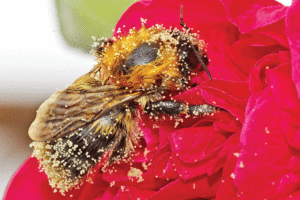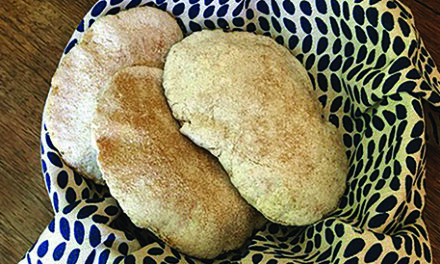
Loaded with pollen, bumble bees can carry up to 80 percent of their body weight.
Ants are often the poster child for being able to carry immense weight relative to their size but bumble bees are no slouch as big lifters of the insect world, either.
While an ant can carry up to 50 times its body weight, the humble bumble bee loads itself up with pollen almost doubling its weight and then has to fly back to the nest.
“They can carry 60, 70 or 80 percent of their body weight flying, which would be a huge load for us just walking around,” said University of California, Davis researcher Susan Gagliardi. “We were curious to see how they do it and how much it costs them to carry food and supplies back to the hive.”
Gagliardi and colleague Stacey Combes, took deep dive into bumble bee flying, using a specially designed chamber resembling an empty snow globe and high speed video.
“We have the bees in a little chamber and we measure the carbon dioxide they produce. They are mostly burning sugar so you can tell directly how much sugar they are using as they are flying,” Gagliardi said.
They attached small pieces of solder wire to the bees to adjust their weight.
They used high-speed video to examine wing beats and movements.
Bumblebees fly in a very different way compared to aircraft, Combes said. While air flows smoothly over an aircraft wing or rotor blade, bees move their wings at a high angle to the air generating vortices that curl round the wing. This produces much more lift than smooth airflow, but it is unstable as the vortices quickly break down. Bees are able to sustain flight by moving their wings very rapidly.
Because bumblebees fuel flight from the nectar they are carrying, they should get lighter as they fly and use less energy. But to their surprise, Combes and Gagliardi found that the bees could actually use less energy per unit load when they were more heavily laden.
“They get more economical in flying the more heavily loaded they are, which doesn’t make any sense in terms of energetics,” Combes said.
Looking closely, the researchers found that bumblebees have two different ways to cope with increasing loads.
They always increase stroke amplitude, or how far the wings flap, when they are more heavily loaded, but this isn’t enough to support the extra weight on its own. To make up the difference, bees increase their wingbeat frequency, which generates more lift and increases energetic cost.
But bees also have an alternative, subtly different flying mode that allows them to carry heavier loads while expending less energy than when they increase flapping frequency.
It’s not yet clear exactly what this “economy mode” involves, Combes said, but it is something the bees can chose to do, or not.
“It turns out to be a behavioral choice they are making in terms of how they support the load,” Combes said.
When bees are lightly loaded or rested, they are more likely to increase wingbeat frequency. When they are more heavily loaded, they switch to the mysterious economy mode, producing enough force to support the load with only a small increase, or even a decrease, in flapping frequency.
Think of it like the car that has buttons for Sport or Performance mode and one for its own economy mode.
When you’re driving alone and out on a weekend trip, you may switch over to the sporty side but when the kids are in the car or its all business during the week, economy mode is a better fit.
It’s not clear why, if the bees can save energy while flying in economy mode. They don’t do it all the time, but it may be that high wingbeat frequency has performance advantages, for example in maintaining stability in turbulent air or avoiding obstacles, Combes said.
All this switching and heavy lifting works up an appetite in the buzzing bees, too, but they are keen to stay off of the junk food aisle.
Using a two-step mechanistical approach that included learning and feeding experiments, German scientists at the University of Munich established a new way to literally keep a close eye on the feeding habits of insects.
“Bees obtain most of their nutrients from their main food sources, which are nectar and pollen. While nectar is mainly a source of carbohydrates, pollen contains most of the other necessary nutrients: proteins, fat, minerals and vitamins.
Until today, most bee researchers assumed that bees, like other herbivores, mainly consider the protein content when choosing their food,” Leonhardt said.
As a first step, learning experiments helped the scientists to establish the bumble bees’ preference for certain nutrients — in this case fat and protein.
“We are focusing on fatty and amino acids, which represent the two essential pollen macro nutrients and which are likely to be perceived and thus tasted by bees,” said researcher Fabian Rüdenauer
The researchers found that bumble bees could clearly differentiate between normal pollen and pollen with increased fat content and did show a clear preference for normal pollen.
Surprisingly, the bumble bees made no clear distinction when the pollen amino acid content was altered in the same way.
“The more fat the pollen contained, the less the bumble bees consumed that pollen,” Leonhardt concluded.
Bumble bees actually accepted death over having to consume the high-fat pollen.
That’s pretty extreme, yes, but the researchers found that laying off fatty foods is much more serious than for humans going out for a greasy burger and fries.
Fat in pollen adversely affects the bumble bees’ reproductive capabilities and survival, they said.
So while from our perspective the flight of the bumble bee looks clumsy and erratic, but those little powerful pollinators know exactly what they’re doing.




